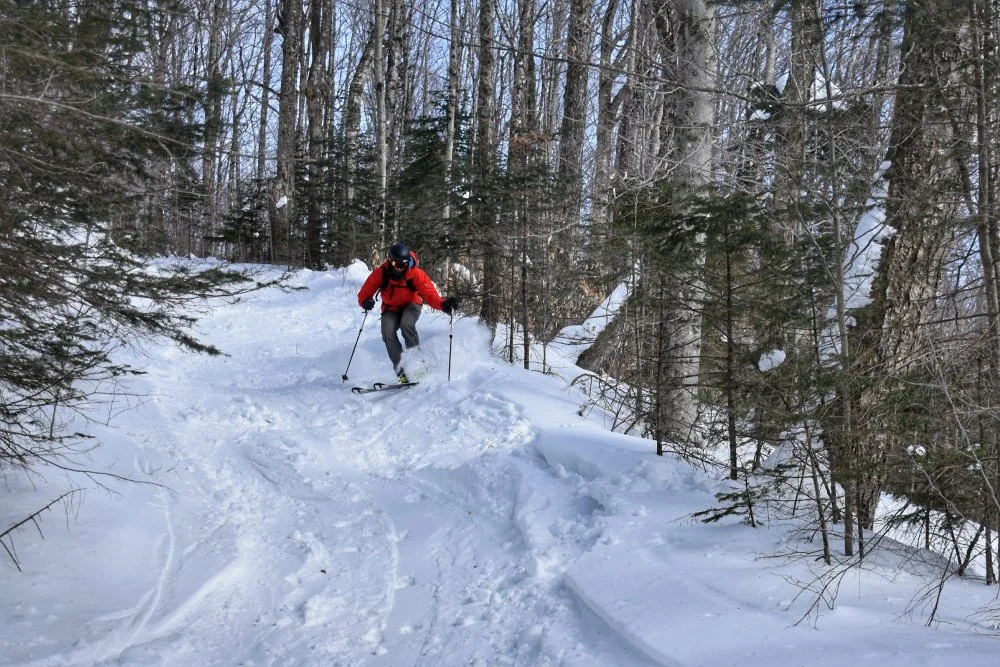The Joy of Traditional Snowshoes
You’ve probably seen an old pair of traditional snowshoes hanging as decoration on someone’s barn or maybe at your favorite après ski locale. Compared to the modern offerings found at your local EMS or REI they likely seem oversized. They are also lacking in the “must-have” features of modern snowshoes like toe spikes and cleats, which are designed to provide traction on steep packed or icy trails. However, traditional snowshoes were designed to serve an entirely different purpose—to provide floatation for off-trail travel in deep, untracked winter snowpacks.
Various forms of the traditional snowshoe exist, from the long Huron snowshoe with its distinctive tail to help tracking on long journeys, to the more nimble Bear Paw which offers maneuverability in dense woods, and many others. But they all share one thing—greater float in deep snow than any modern snowshoe. This feature along with their surprisingly light weight makes them a joy to use in rolling or flat terrain, especially off trail, after a massive storm. You should check them out.
What to get:
For someone just dipping their toes into the water of traditional snowshoes a pair of Bear Paws or Green Mountain pattern snowshoes are ideal. They offer great float, without being so long that they take time to get used to walking in. From trails, to dense woods, to putting in miles on frozen lakes, Green Mountain pattern snowshoes are ideal in a diverse array of terrain. They come in various designs, and some shops still make and sell ones laced in the traditional material of rawhide. Alternatively, some modern versions are laced with thick monofilament fishing line, which requires little maintenance while still providing the benefits of the traditional design. These are often lighter than less well-crafted rawhide versions, but heavier than those made by master snowshoe makers who have perfected their craft.
For bindings, there are various versions available. Some resemble what is used in modern snowshoes, and are a great entry point, being more familiar to those comfortable with modern snowshoes. These allow the use of modern footwear that has a ridged sole. The downside is that they add weight to the snowshoe as does the ridged modern footwear which increases the effort required with each step.
For those more willing to embrace traditional ways, great comfort and weight savings can be realized by combining lampwick bindings with winter moccasins or mukluks. The leather soles of moccasins and mukluks pair perfectly with the lampwick binding and they are my preference when using a traditional snowshoe. While it is possible to use them with modern footwear, the result will be less optimal compared to the traditional pairing which allows better movement of the foot with the snowshoe.
Where to go
For the best traditional snowshoeing experience, get off the beaten path. A well-packed trail negates the float of the traditional snowshoe, and in those instances, I reach for my trusty MSR Ascents. Likewise, on the steep trails on many 4000 footers in the Whites, I will also reach for the Ascents because of their increased traction in steep terrain. But after a big snowfall, on rolling terrain, or off trail, the traditional snowshoe is a joy to use.
The traditional snowshoe is also great for winter camping when pulling a pulk or toboggan with all of your gear. The greater float and wider stance leave a perfect trail that makes pulling a toboggan easy work, or at least as easy as it can get.
Alternatively, a great adventure on traditional snowshoes is to go on a guided trip with someone specializing in traditional winter camping such as Lure of the North or Jack Mountain Bushcraft. Not only is a guided trip a great way to become comfortable with your new snowshoes but you will also learn to love winter camping, how to safely utilize a hot tent and assess, and how to cross frozen lakes.
So the next time you look at that old pair of snowshoes hanging up above the bar think about the grand adventures such a pair could take you on and the history of those who traveled that way before.
Resources
By Scott Powers. If you liked Scott’s post, consider sending him a few bucks. (Venmo: @scott-powers-0)






